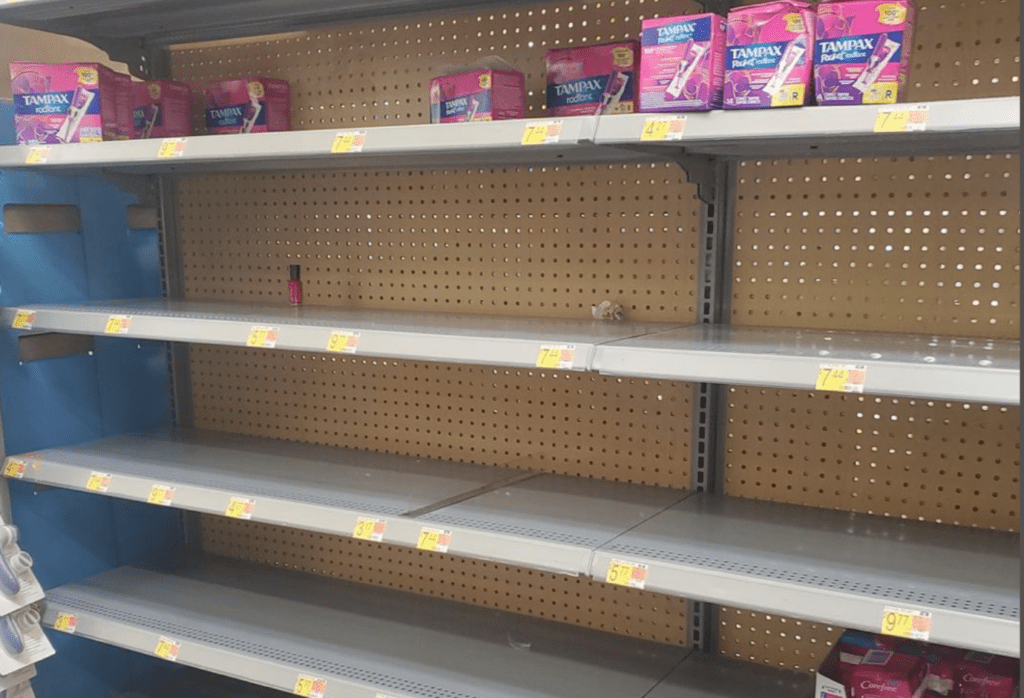In the United States, a concerning yet mostly until now underreported crisis has been plaguing the country for the past two years: a shortage of tampons.
Consumers have posted images on social media highlighting the scarcity of tampons on shelves across America’s supermarkets and pharmacies.
Supply-chain disruptions caused by the global pandemic is just one of many factors attributed to this crisis, as well as huge labour and truck shortages disrupting the usual logistics of restocking tampons in stores across the country.
The issue was first brought to international attention after TIME magazine published an article explaining the crisis earlier this month.
According to the The Wall Street Journal, Arkansas and West Virginia have experienced the biggest shortage, while elsewhere, “an average of 7 per cent of tampons were out of stock in US stores,” over a period of one week in June.
The price of tampons has also risen in the past few months. Last week, Bloomberg reported the average price of a package of tampons went up 9.8 per cent, while the average price of sanitary pads rose 8.3 percent.
According to data from Nielsen IQ, the price of feminine products in the U.S. has gone up by 10.8 per cent since last year.
Manufactures have also exclaimed the rising costs of delivering their products to its consumers.
Thyme Sullivan, co-founder and CEO of TOP The Organic Project, told TIME that the cost of supplying its tampons to the U.S. has risen by 300 per cent from last year.
Sullivan believes the shortage of tampons is due largely to the fact that men run the majority of these manufacturing companies. “It wasn’t on their radar,” she said.
The company began flying its products from Italy, instead of shipping it, since shipping has become difficult and expensive.
Pricie Hanna, a managing partner a a consulting firm specialising in non-woven products, called the supply chain issue “very volatile and unpredictable.”
She noted that the raw materials needed to make tampons, such as cotton and rayon (viscose) has historically been imported from Asia and Europe to the U.S since domestic production was insufficient.
Since the start of the pandemic however, these raw materials, including plastic for applicators—have gone into producing COVID-related medical products such as personal protection equipment.
Demand for these materials has also seen the average price for them rise.
In the US, roughly 40 percent of women use tampons.
With soaring prices and increasing challenges to access to tampons, advocate groups believe this crisis will disproportionately affect those in lower-income communities.
One survey from 2019 found that 64 per cent of low-income women in St Louis, Missouri said they could not afford menstrual products at one point during the past year.
More than one in five women said they faced that problem every month, while almost half claimed to be unable to afford to buy both food and menstrual hygiene products during the past 12 months.
One spokesperson for a tampon manufacturing company told Al Jazeera that “extensive workforce shortages caused by two separate Omicron surges”, impacted the production of its products at its U.S manufacturing facility last year.
“We have been operating our manufacturing facilities around the clock to build back inventory and anticipate returning to normal levels in the coming weeks,” the spokesperson said in an email.
Other contributing factors to the shortage include mass buying of tampons from consumers after they heard about the shortage, as well as the fact that summer is approaching in the northern hemisphere, which means there’ll be a seasonal increase in tampon usage as people engage in water activities.
Last week, White House press secretary Karine Jean-Pierre made no clear indication as to whether President Joe Biden was doing anything to address the tampon shortage crisis.
“I would have to check in with the team on what they’re tracking. I don’t have a list for you right now,” she said.
Last week, US Senator for New Hampshire Margaret Wood Hassan wrote a letter to Procter & Gamble CEO Jon Moeller, encouraging the company to “take quick action” on the crisis.
She also criticised the “price gouging” of the products, asking the CEO to provide “justifications for the price increases that we have seen over the past year”.
“Access to menstrual products should be treated like every other essential good,” Hassan wrote.
“At the beginning of the pandemic, price gouging of essentials like toilet paper, cleaning supplies, and hand sanitiser was rightly criticised as an exploitation of an emergency for financial gain. Menstrual products should receive that same consideration.”
In the meantime, consumers are being forced to seek out alternatives to tampons while the challenges are being addressed.
“They may be recalibrating exactly how to provide that protection based on what they were able to buy this week,” Pricie Hanna told Al Jazeera.
“I think we may already see this week some improvement in the shelf availability in retail stores, but it honestly depends very much on what store you look at and what time of day you check it.”


